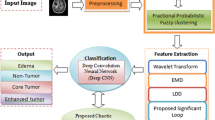Abstract
The Accurate segmentation and classification takes place a major role in the medical image processing to detect and locate the abnormal tissue region. In this, the three different types of brain magnetic resonance imaging (MRI) image source such as Type-1, Type-2 and Fluid attenuated inversion recovery are combined by the image registration process to detect the clear region of the tumor tissue since, the region of interest identification in the single image data contains less key points to define it. In this paper, we implement the ensemble technique of image segmentation to segment the tumor region of the brain MRI image. For the segmentation process, the images are pre-processed by Laplacian cellular automata filtering method and segmented by ensemble of different clustering method such as K-means, fuzzy based clustering, self-organization map (SOM) and ensemble of Gaussian mixture model, K-means, SOM and their results are compared. This ensemble cluster label is consider as the segmented result and classify the abnormalities by using deep super learning method. The experimental results and the comparison charts defines the performance rate of proposed method comparing to the other state-of-art methods. The average accuracy for the proposed work is 98% in Ensemble 1 and 97% in Ensemble 2 methods for the BraTS brain image dataset.

















Similar content being viewed by others
References
Alqurashi T, Wang W (2019) Clustering ensemble method. Int J Mach Learn Cybern 10(6):1227–1246
Bidlo M (2020) Evolution of cellular automata with conditionally matching rules for image filtering. In: 2020 IEEE congress on evolutionary computation (CEC), vol 1. IEEE, pp 1178–1185
Chanu MM, Thongam K (2020) Computer-aided detection of brain tumor from magnetic resonance images using deep learning network. J Ambient Intell Human Comput 12:6911–6922
Chen H, Qin Z, Ding Y, Tian L, Qin Z (2020) Brain tumor segmentation with deep convolutional symmetric neural network. Neurocomputing 392:305–313
de Vos BD, Berendsen FF, Viergever MA, Sokooti H, Staring M, Išgum I (2019) A deep learning framework for unsupervised affine and deformable image registration. Med Image Anal 52:128–143
Fan J, Cao X, Yap PT, Shen D (2019) Birnet: brain image registration using dual-supervised fully convolutional networks. Med Image Anal 54:193–206
Hosseini MJ, Gholipour A, Beigy H (2016) An ensemble of cluster-based classifiers for semi-supervised classification of non-stationary data streams. Knowl Inf Syst 46(3):567–597
Jothi G et al (2016) Hybrid tolerance rough set-firefly based supervised feature selection for MRI brain tumor image classification. Appl Soft Comput 46:639–651
Kageyama S, Mori N, Mugikura S, Tokunaga H, Takase K (2021) Gaussian mixture model-based cluster analysis of apparent diffusion coefficient values: a novel approach to evaluate uterine endometrioid carcinoma grade. Eur Radiol 31(1):55–64
Krishnakumar S, Manivannan K (2020) Effective segmentation and classification of brain tumor using rough k means algorithm and multi kernel SVM in MR images. J Ambient Intell Human Comput 12:6751–6760
Li H, Li A, Wang M (2019) A novel end-to-end brain tumor segmentation method using improved fully convolutional networks. Comput Biol Med 108:150–160
Narmatha C, Eljack SM, Tuka AARM, Manimurugan S, Mustafa M (2020) A hybrid fuzzy brain-storm optimization algorithm for the classification of brain tumor MRI images. J Ambient Intell Human Comput. https://doi.org/10.1007/s12652-020-02470-5
Nilashi M, Ahmadi H, Manaf AA, Rashid TA, Samad S, Shahmoradi L, Aljojo N, Akbari E (2020) Coronary heart disease diagnosis through self-organizing map and fuzzy support vector machine with incremental updates. Int J Fuzzy Syst 22:1376–1388
Rajesh T, Malar RSM, Geetha M (2019) Brain tumor detection using optimisation classification based on rough set theory. Clust Comput 22(6):13853–13859
Saravanan S, Karthigaivel R, Magudeeswaran V (2020) A brain tumor image segmentation technique in image processing using ica-lda algorithm with arhe model. J Ambient Intell Human Comput 12:4727–4735
Saxena N, Sharma K (2017) Image fusion scheme using two dimensional discrete fractional Fourier transform. In: 2017 conference on information and communication technology (CICT), vol 1. IEEE, pp 1–6
Srinivasan A, Sadagopan S (2021) Rough fuzzy region based bounded support fuzzy c-means clustering for brain MR image segmentation. J Ambient Intell Human Comput 12(3):3775–3788
Tongbram S, Shimray BA, Singh LS, Dhanachandra N (2021) A novel image segmentation approach using FCM and whale optimization algorithm. J Ambient Intell Human Comput. https://doi.org/10.1007/s12652-020-02762-w
Verma H, Agrawal R, Sharan A (2016) An improved intuitionistic fuzzy c-means clustering algorithm incorporating local information for brain image segmentation. Appl Soft Comput 46:543–557
Wang Y, Li C, Zhu T, Zhang J (2019) Multimodal brain tumor image segmentation using WRN-PPNET. Comput Med Imaging Graph 75:56–65
Wu J, Tang X (2020) A large deformation diffeomorphic framework for fast brain image registration via parallel computing and optimization. Neuroinformatics 18(2):251–266
Xiao W, Yang Y, Wang H, Li T, Xing H (2016) Semi-supervised hierarchical clustering ensemble and its application. Neurocomputing 173:1362–1376
Yang X, Kwitt R, Niethammer M (2016) Fast predictive image registration. In: Deep learning and data labeling for medical applications, vol 10008. Springer, pp 48–57
Young S, Abdou T, Bener A (2018) Deep super learner: a deep ensemble for classification problems. In: Canadian conference on artificial intelligence, vol 10832. Springer, pp 84–95
Zhong C, Hu L, Yue X, Luo T, Fu Q, Xu H (2019) Ensemble clustering based on evidence extracted from the co-association matrix. Pattern Recognit 92:93–106
Author information
Authors and Affiliations
Corresponding author
Additional information
Publisher's Note
Springer Nature remains neutral with regard to jurisdictional claims in published maps and institutional affiliations.
Rights and permissions
About this article
Cite this article
Ramya, P., Thanabal, M.S. & Dharmaraja, C. Brain tumor segmentation using cluster ensemble and deep super learner for classification of MRI. J Ambient Intell Human Comput 12, 9939–9952 (2021). https://doi.org/10.1007/s12652-021-03390-8
Received:
Accepted:
Published:
Issue Date:
DOI: https://doi.org/10.1007/s12652-021-03390-8




